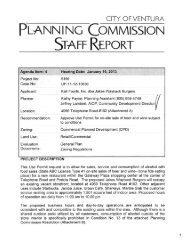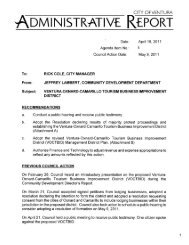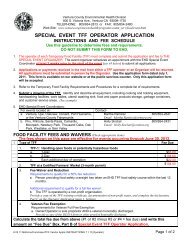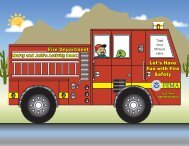Saticoy & Wells Community Plan & Development ... - City Of Ventura
Saticoy & Wells Community Plan & Development ... - City Of Ventura
Saticoy & Wells Community Plan & Development ... - City Of Ventura
You also want an ePaper? Increase the reach of your titles
YUMPU automatically turns print PDFs into web optimized ePapers that Google loves.
<strong>Saticoy</strong> & <strong>Wells</strong> <strong>Community</strong> <strong>Plan</strong> and Code EIRSection 4.3 Air QualityAn important fraction of the particulate matter emission inventory is that formed by dieselengine fuel combustion. Particulates in diesel emissions are very small and readily respirable.The particles have hundreds of chemicals adsorbed onto their surfaces, including many knownor suspected mutagens and carcinogens. The California <strong>Of</strong>fice of Environmental Health HazardAssessment (OEHHA) reviewed and evaluated the potential for diesel exhaust to affect humanhealth, and the associated scientific uncertainties (California EPA, ARB, April 1998). Based onthe available scientific evidence, a level of diesel PM exposure below which no carcinogeniceffects are anticipated has not been identified. The Scientific Review Panel that approved theOEHHA report determined that based on studies to date that 3 x 10-4 (µg/m 3 )-1 is a reasonableestimate of the unit risk for diesel PM. This means that a person exposed to a diesel PMconcentration of 1 µg/m 3 continuously over the course of a lifetime has a 3 per 10,000 chance (or300 in one million chance) of contracting cancer due to this exposure. Based on an estimatedyear 2000 statewide average concentration of 1.26 µg/m 3 for indoor and outdoor ambient air,about 380 excess cancer cases per one million population could be expected if diesel PMconcentrations remained the same (ARB, October 2000).Diesel PM emissions are estimated to be responsible for about 70% of the total ambient air toxicsrisk. In addition to these general risks, diesel PM can also be responsible for elevated localizedor near-source exposures (“hot spots”). Depending on the activity and nearness to receptors,these potential risks can range from small to 1,500 per million or more (ARB, October 2000).Risk characterization scenarios have been conducted by the ARB staff to determine the potentialexcess cancer risks involved due to the location of individuals near to various sources of dieselengine emissions, ranging from school buses to high volume freeways.Diesel PM emissions are expected to decline 30% from 2000 to 2020 due to currently adoptedon-road standards and fleet turnover as new vehicles with controls replace older vehicles withlittle or far less effective controls, but such reductions will not be sufficient to fully reduce theexisting risk. In addition, ARB staff have prepared a Diesel Risk Reduction <strong>Plan</strong> (ARB, October2000) that includes a comprehensive plan to further reduce diesel PM emissions. The ARB is inthe process of developing specific regulations to implement the plan. The basic concept is torequire all new diesel-fueled vehicles and engines to use state-of-the-art catalyzed dieselparticulate filters (DPFs) and very low-sulfur diesel fuel. Also, where technically andeconomically feasible, the ARB staff recommends that existing vehicles and engines should beretro-fitted to further reduce particulate emissions. For example, the ARB in 2001 adopted newPM and NOx emission standards to clean up large diesel engines that power big-rig trucks,trash trucks, delivery vans and other large vehicles. The new standard for PM takes effect in2007 and reduces emissions to 0.01 gram of PM per brake horsepower-hour (g/bhp-hr.), a 90%reduction from the existing standard.The USEPA is also working to reduce the emissions from diesel engines. The USEPA finalized anew rule in December 2000 for on-road vehicles requiring petroleum refiners to remove all but15 ppm of sulfur from diesel fuel by mid-2006, and requiring engine makers to reduceparticulate matter emissions by almost 90% and NOx levels by up to 95% for new engines bythe model year 2007.4.3-4<strong>City</strong> of <strong>Ventura</strong>
















